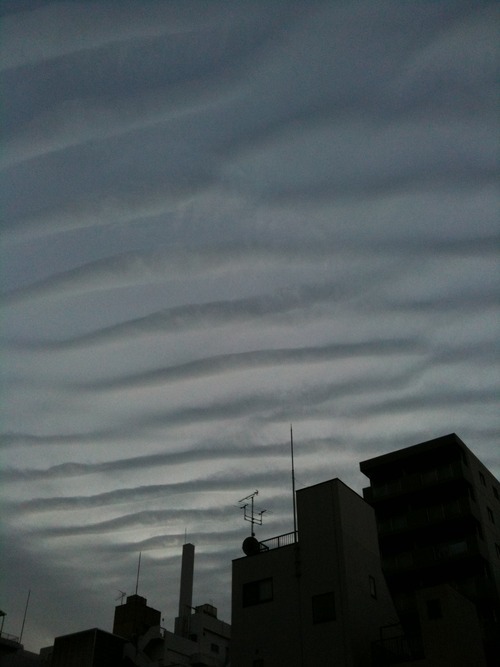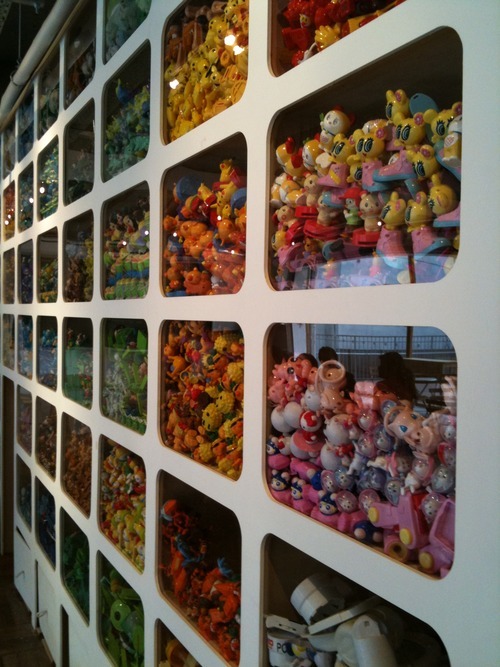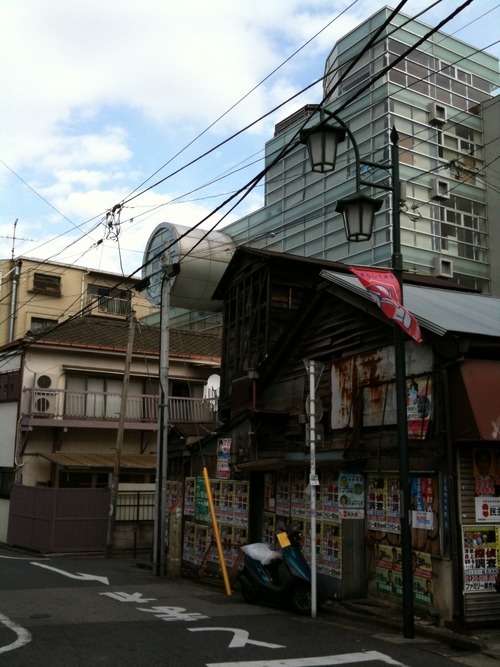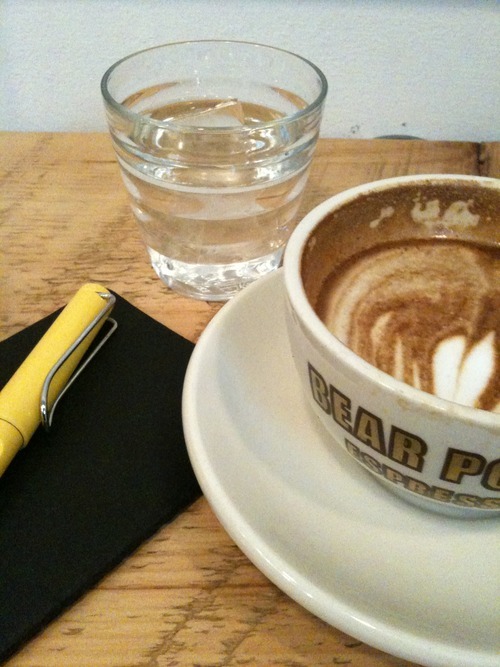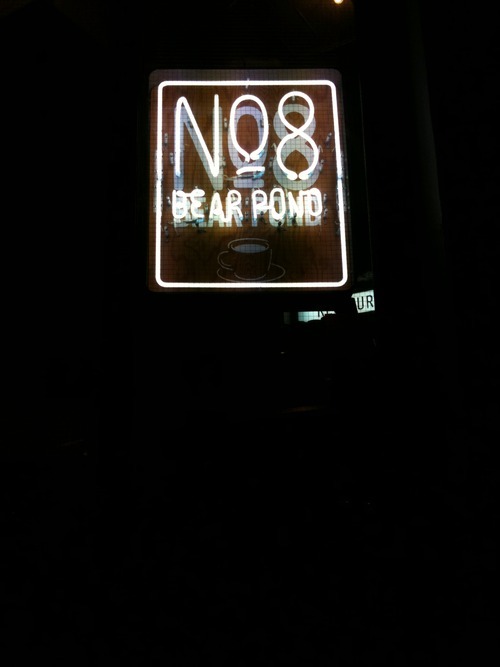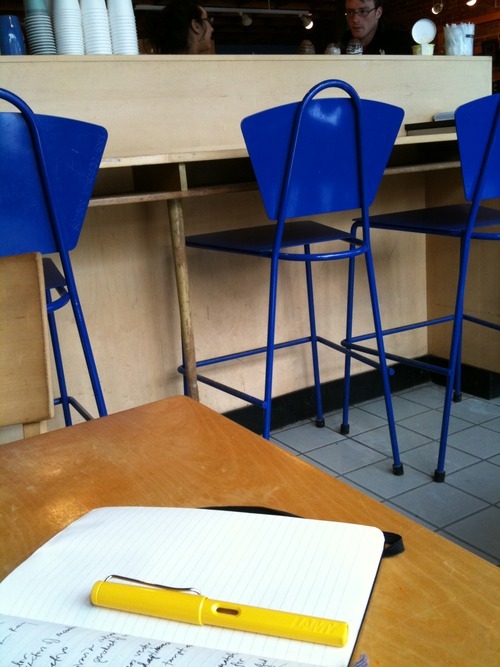
Jan 29, 2011
Jan 25, 2011
post-japan note #1
in tokyo, i noticed many people wearing facemasks and assumed, naturally, that they were hypochondriacs. darryl explained that sick people wore them to protect those they had to interact with from infection. this consideration is both pleasant and refreshing.
Posted by
vaughn tan
1 comments
![]()
![]()
Labels: execution success, neat, tokyo
Jan 18, 2011
refreshments
- a prince edward (white horse blend, cocchi americano, drambuie)
- a dry and oxidised bamboo (old dry oloroso, dry vermouth, bitters)
- an original sidecar (pierre ferrand, cointreau, lemon)
Posted by
vaughn tan
1 comments
![]()
![]()
Labels: drink, execution success
the art of living
The art of living is one and indivisible. A master in the art of living draws no sharp distinction between his work and his play; his labor and his leisure; his mind and his body; his education and his recreation. He hardly knows which is which. He simply pursues his vision of excellence through whatever he is doing, and leaves others to determine whether he is working or playing. To himself, he always appears to be doing both.
Posted by
vaughn tan
0
comments
![]()
![]()
Labels: art, execution success, instruction, intransigence, intuition, moral fibre, scalefree, theory, translation
Jan 13, 2011
Jan 12, 2011
in which i manage not to miss dinner
1/12/2010: darryl sends further details and corrections, now seamlessly incorporated below.
the best meal in tokyo was also the most interesting, the best value (by a long shot), the last, and the one i came close to bailing on to take a nap.
darryl and saemi skipped a day of work to bring me around suburban tokyo. we had breakfast and lunch in yoyogi-uehara, a tiny cluster of low-rise residential neighbourhoods near shibuya that is the improbable home to at least five orthopedic surgeries, three boulangeries, one patissier, and a homestyle japanese restaurant masquerading as a bhutanese diner. eventually, we ended up back in the city center, at a smoky coffee shop called saboru in jimbocho drinking indifferent but very expensive coffee and watching the bar staff dry saucers very efficiently.*
i was getting sleepy and tried to beg off dinner way out in the west in asagaya, but darryl kept on my case. eventually we jumped on the tozai line out to asagaya, and then into the warren of streets surrounding the station. 水鳥屋 鶴に橘 is the name (i'm incompetent at reading hiragana or romanising kanji), and apparently it's been open less than a year. the inside has been mostly left alone, and we think it must have been, in the past, a hotpot restaurant or something of the sort.
there was one other guy eating and drinking at the counter when we showed up, and then a woman arrived much later to do much the same thing as he was doing: a few flasks of sake and what appeared to be a continuing flow of small eats and intermittent banter. the restaurant is the kind of neighborhood bar we all wish we had. good food, good drinks, small enough, and in a small enough neighbourhood that people get to know you without knowing you too well. it has a counter that seats maybe 6 people, two tables for 4 each, and one chef behind the counter (in jeans and a tie).
the restaurant had a short, serious-looking sake list and an amusing range of temperatures at which sake could be ordered (amusing because some, or at least one, was a pun in japanese which i didn't understand but everyone tittered about). we had a daiginjo (brewed by koikawa) followed by a wata-ya daiginjo (brewed by miyagi). both were good, the latter was better (more crisp, drier, extremely clean). each generous pour for the table was around 800¥, or about $10. a great deal. we decided to spring for the course dinner: 8 courses for 3150¥, or $40, plus another 1600¥ for two sakes (daiginjos from koikawa and miyagi). the food was remarkable.
- japanese leek puree (he got his leeks from shimonita), under slices of poached duck breast, with japanese eggplant cooked in the fashion of holland (apparently this means frying it first, then simmering it in dashi). the duck was tough and the skin had not been seared and rendered, even though it had been correctly scored for this. duck has to either be served rare or cooked low and slow. and putting an awesome sauce underneath foods often means wasted sauce and imperfectly sauced foods. i was sad to see the negi puree go. put this down as another instance where the tectonics of food would have been a fruitful study.
- a tray of lots of things: a dish of cubes of boiled, then cooled celery and shredded aburage tofu; a pile of blanched chrysanthemum leaves; a soupspoon with a halved quail egg smothered in tuna-flavoured mayonnaise; a cube of steamed sweet potato (an-no imo?); a shotglass of pureed sweet potato soup; and most wondrous of all, a square of nori and dashi gel. the agar was the perfect consistency (barely holding together, disappearing on the tongue but with detectable texture; also see previous grumbling about gels), it had also been made with a richly flavoured dashi and held in suspension a little festival of untoasted nori. this course was billed as appetisers, but could easily have been an unorthodox take on the composition of a traditional hassun course (for more on kaiseki, see here), which comprises foods from the seas and the mountains or from the rivers and the fields. in this case, the tuna sauce and the nori and dashi gel are the foods from the seas (instead of a bit of sashimi or sushi), and the chrysanthemum leaves, celery, sweet potato, and quail egg are the foods of the fields and mountains. extra points for making a little square that is essentially the sea: seaweed suspended in a gel made of seaweed extract dissolved in fish and seaweed extract. this little square was one of the best things in the entire meal.
- the bowl course was a square of fried gomadofu, topped with a piece of broiled yellowtail, garnished with a flake of yuzu peel and a tangle of shungiku, the whole afloat in pellucid dashi with the smallest scatter of shimmering oil droplets on top even though it was surrounding two oily things. gomadofu is a gel made of sesame paste set with arrowroot starch, most often served to open a shojin kaiseki meal. the gomadofu was brilliant and unusual in several ways: this piece was coarsely textured where usually smoothness is the objective (achieving a smooth paste when hand-grinding sesame in a suribachi is a long process, and a signal from the chef to the diner at the beginning of the meal); it was made of black sesame where usually the milder white sesame is used; it was fried and served as a component of a course rather than being the focal point of the course. because winter yellowtail is a fatty strong-flavoured fish, the black sesame tofu was a great foil. it's not a flavour combination you encounter often either: sesame, oily fish, bitter greens, and aromatic citrus. this course was probably the best one of the meal; innovative while clearly referencing tradition, perfect in composition and execution, incredibly delicious.
- a pair of nigiri, made of thin slices of beef tataki-style, garnished with wasabi, black truffle salt, and soy. very tasty, with rice perfectly cooked and seasoned. but if any flavour is overused to show people that they're eating premium, that flavour is truffle. the cut of the beef is ichibo, whatever that means. research time!
- stewed pork belly with carrots and daikon cooked almost to the point of disintegration. there was lots of fat in here, and the soup surrounding the pork belly and root vegetables was thick with dissolved collagen. this nimono (or stewed object) course was incredibly homey in style in contrast to the precision of the earlier courses, but satisfyingly delicious. and the rustic presentation concealed some fiddliness in back too. the soup had been defatted and clarified at least a little, because it was unusually clear when it was first presented.
- shiso sorbet to cleanse the palate. this was remarkable. a tiny bright green ball of sorbet. not too smooth, not too grainy, and not too sweet; ie the texture of perfect shaved ice (this is surprisingly difficult to achieve in a sorbet). but the flavour was what blew all of us away; the sorbet was the flavour of the leaf's scent alone, with none of the woodiness at all. he said, when we asked, that he simmered the shiso in white wine, umeshu, and sugar, then added lemon juice before processing. there is something else going on here, but this was ridiculously good sorbet.
- rice to close the meal. a claypot of rice cooked with turnip greens, maitake mushrooms, slivers of broiled yellowtail, and aburage tofu. this was good but not as well-made as the bamboo shoot and chicken claypot at fujimoto in kichijoji. the red miso soup that came with the rice though was really spectacular. super deep flavour.
- dessert was a dairy ice cream made of young savoy cabbage. this was beautiful, green, mildly sweet, recognizably cabbage, with great texture. apparently a simple cream, egg, sugar base with young cabbage leaves blended in, then heated lightly to nappe before processing to drive off some of the sulphides and also green it a little bit more. the unseasonably cold winter has already given the cabbages enough sugar to make something like this work remarkably well.
apparently the chef is the apprentice of the man who now runs guilo guilo in paris, having moved the restaurant there from kyoto. like bondir, i think tsuru ni tachibana is the real deal: small enough to have very little overhead and total control of what gets served. i like this model a lot. there are many good things to be said for being able to go to a restaurant and eat just one person's idea of deliciousness.
the menu changes monthly. if i didn't live thousands and thousands of miles away, i would go back a couple of times a month to see how his expression of deliciousness changes as the raw materials change with the passage of the year. this is the best value meal of 2010 and 2011 to date, and certainly joins the list of nearly perfect meals.
水鳥屋 鶴に橘
〒 166-0001
asagayakita 2-4-7, suginami, tokyo
open mondays through saturdays, 6.30pm until the food's gone; closed sundays.
calling ahead is probably not a bad idea: +81 3 3330 7705
* stack two damp plates and, holding them by the centers with one hand, wipe (with a cloth, in a circular motion, at the same time) the top of the top plate and the bottom of the bottom plate, then reverse the plates and repeat. very quick, if all your plates are the same size.
Posted by
vaughn tan
0
comments
![]()
![]()
Labels: art, execution success, food, intuition, process, theory, tokyo
Jan 11, 2011
Jan 10, 2011
the egg in urban life
below you see the centerfold of a periodical that appears to be devoted to reviews of eggs, and a store that sells only eggs.

Posted by
vaughn tan
0
comments
![]()
![]()
Labels: tokyo
Jan 3, 2011
ensconed*
beatus ille homo* yes, a typo. but it's more amusing this way.
qui sedet in sua domo
et sedet post fornacem
et habet bonam pacem
happy the man
who sits at home
ensconced by the oven
enjoying goodly peace
joseph f. von eichendorff, of the life of a good-for-nothing
Posted by
vaughn tan
0
comments
![]()
![]()
Labels: books
Jan 1, 2011
in which i grumble about gels
happy new year! on this first morning of 2011, a heavy rain falls. last night, everyone brought their wives and children to jc and maud's home, where eventually conversation turned to the cost of living in this tropical paradise. in the last two years, the price of real estate has gone through the roof. who is buying these million-dollar shoebox apartments and how is this sustainable in the long term? the combined brainpower at the overloaded table could provide no answer.
my grumbling is less about the rising price of real estate and more about the rising price of restaurants accompanied only by a precipitous decline in relative quality. not long ago, it was difficult to find a meal here that was so bad it wasn't worth the price, both at the upper and the lower ends of the spectrum: inexpensive food was largely competent and sometimes very good; expensive food was often excellent and only rarely mediocre. there was a small population of moderately expensive restaurants at which "ambience," slightly fancier furniture, long menu descriptions, and trendiness took the place of quality, but they were always easy to detect and avoid. calvin trillin, one of my all-time favourite authors, identified the phenomenon's american incarnation as the restaurants generically known as la maison de la casa house, continental cuisine. he expands considerably on this in "the traveling man's burden" (collected in the tummy trilogies, which i recommend without reservation): "Being in a traveling trade myself, I know the problem of asking someone in a strange city for the best restaurant in town and being led to some purple palace that serves 'Continental cuisine' and has as its chief creative employee a menu-writer rather than a chef."
on this visit, this last group of restaurants appears to have exploded in size, with the additional twist that some now up the ante and inflate the check with what can only be called innovative cuisine if the term is stretched to breaking point. an immersion circulator and a shelf full of hydrocolloids does not make you a master chef (more anon), nor an innovative one.
restaurants shouldn't be cheap, but they should always provide good value (see my list of nearly perfect meals). better something be simple, humble, and well-made than trumped up but mediocre. is this too much to ask? apparently it is. i will illustrate with a meal at pamplemousse, a "bistro+bar" located within the dempsey road encampment (a neighbourhood which has already matured into one of the epicenters of pricey, low-value dining).
pamplemousse offers a relatively inexpensive lunch (about S$40/US$30 for three courses). the first two courses were almost entirely unmemorable except for their depressing mediocrity. frisee salad with lardons was dressed with a magnificent vinaigrette, but the lardons were cold and inconsistently cut and rendered, and the frisee brown and wilted from age rather than the hot bacon fat from freshly fried lardons. the roulade of sous vide hay-smoked chicken was shot through with unrendered, barely warm chicken fat. slices of goose breast were cooked sous vide at too low a temperature so the meat was almost inedibly tough, and then seared so briefly that almost none of the subcutaneous fat rendered out. high point: pork cheeks perfectly gelatinous, with collagen fully hydrolyzed, but spoiled by the thick and pointless layer of crushed hazelnuts on top. i ate with a sense of growing gloom.
real despair set in at the end of lunch, when the desserts emerged and were presented with the flourish almost all poorly made things are introduced with: a panna cotta topped with a layer of gelled red bean paste, served with crumbled mooncake pastry and a scoop of pandan-flavoured ice cream, and an osmanthus flavoured creme brulee with a scoop of lychee sorbet. the panna cotta was as firm as a poorly made sweet potato pie filling. the layer of red bean gel up top was, however, even stiffer and more glutinous, so that it was impossible to use the fork provided to cut a piece of both red bean gel and panna cotta without causing the panna cotta underneath to splay out in all directions. mechanically, a perplexingly poorly conceived dessert. the creme brulee had no detectable aroma of osmanthus but anyway was overcooked: firm in the centre and weeping on the edges; there was not that faint warmth in the top layer from a recently applied torch or salamander to contrast with the chilled custard beneath. and the lychee sorbet was both inedibly sweet and unpleasantly icy at the same time. (sugar, which is hygroscopic, generally retards the formation of large ice crystals but not, apparently, in this case.)
gels, like egg custards and panna cottas, are almost irreducibly simple. all, therefore, is in the execution. they should only be put on menus if their execution can be reliably perfect. creme brulee and panna cotta especially should wiggle on the cusp between solid and liquid, each spoonful vanishing in the mouth as a rush of flavour. for creme brulees, the whole point of their existence is the contrast between an evanescent custard and the brittle layer of burnt sugar on top. panna cottas are barely set with gelatin; when correctly made with the absolute minimum amount of gelatin for the panna cotta to hold its shape, they go from being a soft, chilled solid to a sudden mouthfilling rush of gently cooked cream as the gel matrix collapses (gelatin melts at body temperature and its viscosity in liquid form is what produces the sensation of unctuousness). this all ran through my mind as i poked at the stiffish gels arrayed on the plate.
the icing on the cake (as it were) was the enormous double-height wall in the restaurant, on which was inscribed, in letters high as my head is tall, the names of ingredients favoured by the chef. there were three typos. we left, pausing only for a handwashing. the soap in the bathroom was, of course, grapefruit-scented.
Posted by
vaughn tan
0
comments
![]()
![]()
Labels: execution failure, food, singapore


